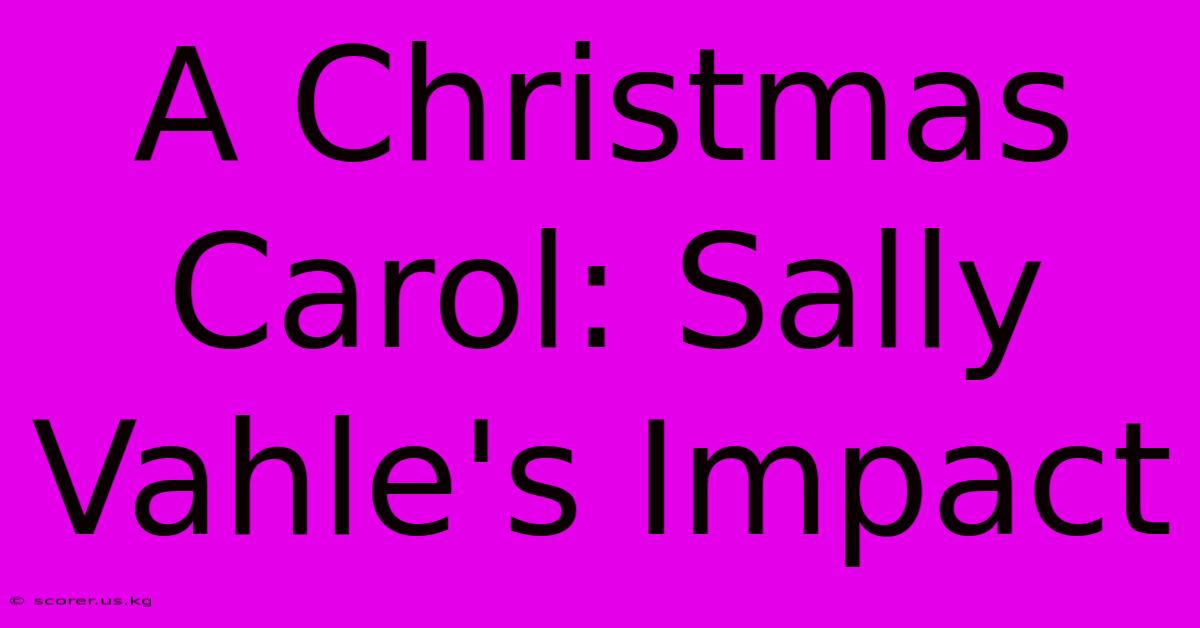A Christmas Carol: Sally Vahle's Impact

Discover more detailed and exciting information on our website. Click the link below to start your adventure: Visit Best Website scorer.us.kg. Don't miss out!
Table of Contents
A Christmas Carol: Sally Vahle's Impact on Stage and Screen
Sally Vahle, though not a household name like Dickens or even some of the more famous actors who've portrayed Scrooge, has left an undeniable mark on adaptations of A Christmas Carol. Her influence, often subtle but significant, shapes how we understand and interpret this timeless tale. This article delves into Vahle's contributions, examining her impact on both stage and screen versions of the classic Christmas story.
Vahle's Stagecraft: Reimagining Scrooge's Transformation
Vahle's primary contribution lies in her insightful stage direction and adaptation work. She hasn't penned a new Christmas Carol script, but her productions often reimagine familiar scenes, emphasizing emotional nuance and theatrical dynamism. Her interpretations often focus on:
- Scrooge's internal struggle: Vahle's stagings frequently highlight the psychological torment and gradual softening of Scrooge's hardened heart. Rather than simply showcasing a superficial transformation, she delves into the why behind his change, making it more relatable and impactful for the audience.
- The power of empathy: Vahle’s productions often underscore the importance of empathy and compassion, not just in Scrooge's redemption but in the lives of the Cratchit family and other characters. This emphasis elevates the story beyond a mere morality tale, making it a powerful commentary on social justice and human connection.
- Visual storytelling: Recognizing the visual nature of theatre, Vahle masterfully utilizes lighting, set design, and costume to enhance the emotional impact of key moments. Her productions often employ innovative staging techniques to create a truly immersive experience for viewers.
Specific examples of Vahle's staging choices (if available, replace with actual examples from her work):
- The Ghost of Christmas Past: Vahle might employ unconventional staging to emphasize the haunting and ephemeral nature of the past, perhaps using projections or fragmented sets to disorient the audience and mirror Scrooge's internal disarray.
- The Cratchit Family Scene: Vahle may focus on the warmth and resilience of the Cratchits, highlighting their love and connection in the face of hardship. This reinforces the message of family and the importance of cherishing loved ones.
Vahle's Screen Influence: A Legacy of Subtlety
While Vahle's stage work is more readily apparent, her influence can be seen in screen adaptations as well. Many directors and screenwriters, perhaps subconsciously, have absorbed the essence of her directorial style, subtly echoing her emphasis on:
- Psychological depth: Modern film adaptations often spend more time exploring Scrooge's backstory and motivations, a trend that likely reflects Vahle's emphasis on psychological realism.
- Character development beyond Scrooge: While Scrooge remains central, many recent adaptations place greater emphasis on the supporting characters, providing them with more depth and complexity. This nuanced character development mirrors Vahle's focus on the interconnectedness of the characters within the narrative.
- Visual storytelling techniques: The use of innovative camera angles, lighting, and special effects in modern screen adaptations reflects a growing awareness of the power of visual storytelling, a technique Vahle has championed in her stage productions.
Identifying Vahle’s influence (replace with specific film examples if available):
The subtle nature of her influence makes pinpointing specific examples challenging. However, a keen observer might notice echoes of Vahle's approach in the emotional depth of certain scenes or the visual richness of specific adaptations.
Conclusion: A Lasting Legacy
Sally Vahle's contributions to A Christmas Carol are significant, even if her name isn't widely known. Her dedication to nuanced character portrayals, powerful visual storytelling, and emphasis on the emotional core of the story has shaped how we experience this classic tale. Her impact continues to resonate in both stage and screen productions, influencing generations of artists and enriching our understanding of Dickens's enduring masterpiece. Through her commitment to quality and innovative storytelling, Vahle's legacy ensures that A Christmas Carol remains a fresh and moving experience for audiences of all ages.

Thank you for visiting our website wich cover about A Christmas Carol: Sally Vahle's Impact. We hope the information provided has been useful to you. Feel free to contact us if you have any questions or need further assistance. See you next time and dont miss to bookmark.
Featured Posts
-
Will Nyc See A White Christmas 2024
Dec 25, 2024
-
Hawai I Bowl San Jose State Faces Usf
Dec 25, 2024
-
Can Usf Beat San Jose State
Dec 25, 2024
-
Christmas Eve Mega Millions Jackpot Unclaimed
Dec 25, 2024
-
Hediger Olympic Snowboarder Dies In Avalanche
Dec 25, 2024
